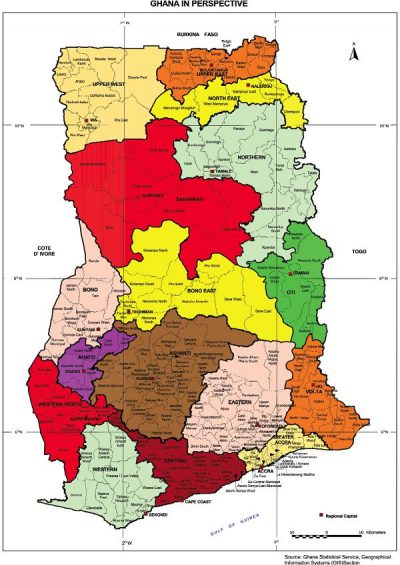The Curious Case of SALL
 In this post, I summarise the key events leading to the Electoral Commission of Ghana’s failure to hold parliamentary elections in the traditional areas of Santrokofi, Akpafu, Lipke and Lolobi (SALL).
In this post, I summarise the key events leading to the Electoral Commission of Ghana’s failure to hold parliamentary elections in the traditional areas of Santrokofi, Akpafu, Lipke and Lolobi (SALL).
Events
- 12 October 2017 – Presidents sets up Commission of Inquiry Into The Creation Of New Regions 2017 (C.I. 105).
- 19 October 2017 – President inaugurates a 9-member commission chaired by Justice Brobbey to look into the petitions submitted to the President by residents in Brong-Ahafo (BA), Northern (NR), Volta (VR) and Western Regions (VR).
- 26 June 2018 – Justice Brobbey Commission submits its work to the President and recommends the creation of six new regions from the existing BA, NR, VR and WR.
- 30 October 2018 – Referendum (Creation of New Regions) Regulations 2018 (C.I. 109) is laid before Parliament and referred to the Committee on Subsidiary Legislation and Report.
- November 2018 – Parliament recommends that the C.I. 109 be adopted and come into force at the expiration of 21 sitting days as required by Article 11(7) of the 1992 Constitution.
- 27 December 2018 – Electoral Commission (EC) holds a referendum in parts of the existing BA, NR, VR and WR affected by the proposal to create six new regions. More than 80% of the over 50% turnout voted yes to creating the new regions.
- 2 January 2019 – The EC gazettes results of the Referendum.
- 1 February 2019 – President makes C.I. 112, C.I. 113, C.I. 114, C.I. 115, C.I. 116, C.I. 117 creating Oti Region, Bono East Region, Ahafo Region, Savannah Region, North East Region and Western North Regions respectively.
- By the Schedule to C.I. 112, the traditional areas of SALL fall under the Oti Region. However, The Representation of People (Parliamentary Constituencies) Instrument 2016 (C.I. 95), which delimits Ghana’s constituency boundaries, places the said traditional areas in the Hohoe Constituency in the Volta Region.
- 17 December 2019 – EC conducts District Level Elections and Unit Committee Elections nationwide. The District Electoral Areas and Designation of Units Regulations 2019 (C.I. 119) delimited boundaries of various districts and placed SALL in the Jasikan District in the Oti Region.
- February 2020 – Chiefs of Akpafu and Lolobi traditional area file a matter in the Supreme Court on the allocation of Akapfu and Lolobi to Jasikan District in the Oti Region. The court struck out the matter because it lacked jurisdiction.
- 24 June 2020 – The Supreme Court in Valentine Edem Dzatse v Henry Ametefe decided that under Article 47(2) SALL must be in the Oti Region and the provision in C.I. 95 which places SALL in the Hohoe Constituency of the Volta Region is unconstitutional. Consequently, the court ordered the EC to take the necessary steps to amend C.I. 95 so that any review in the constituencies take effect on 7 January 2021.
- 7 July 2020 – EC makes The Representation of People (Parliamentary Constituencies) Instrument 2020 (C.I. 128) which came into force on 11 August 2020. EC places SALL in the Buem Constituency with Jasikan as its District Headquarters.
- 3 August 2020 – The President through the Minister for Local Government directs Regional Minister to ensure that the people of SALL have their local government status before the end of 2020 instead of being included in the Jasikan District.
- 6 October 2020 – Local Government (Guan District Assembly) (Establishment) Instrument, 2020 together with six other local government instruments is laid before Parliament.
- 6 November 2020 – L.I. for Guan District matures in Parliament and comes into force. LIs for Krachi West, Kwahu South, Asante Akim North, Akatsi South and Bulisa North also matured and elevated to a Municipal Assembly status.
- 7 November 2020 – Parliament goes on recess ahead of 2020 general elections.
- 6 December 2020 – EC announces that voters in the Guan District will only vote in the Presidential Election but not in the Parliamentary Election in the Buem Constituency.
Conclusion
Article 47(2) provides that a constituency must not fall within more than one region. In addition to this requirement, the EC has stated that a constituency boundary cannot fall within two districts. Although this position is not supported by Article 47(2), this view has been upheld by the EC based on its interpretation of local government laws since 2003. (See: Electoral Commission of Ghana – Elections 2004: Ghana’s Parliamentary and Presidential Elections. Friedrich Ebert Stiftung 2005). Post-2003, the EC’s actions have led to an increase in the number of constituencies from 200 to 275.
With Parliament on recess and 26 years “precedent” of demarcating constituencies after new districts are created, the EC could not lay the appropriate C.I. in Parliament for the requisite twenty-one days before the 7 December 2020 general elections.
We have reaped the “benefits” of the EC’s wrong interpretation on the demarcation of constituency boundaries. The time has come for the EC to revisit the redistribution of constituencies to ensure that the number of inhabitants in each constituency is, as nearly as possible, equal to the population quota as set out in Article 47 of the constitution. (See Daniel A. Smith The Re-demarcation and Reapportionment of Parliamentary Constituencies in Ghana. CDD Briefing Paper Vol. 10 No. 2).


Excellent summary of events.
Very good brief on this matter and brings clarity to this matter.